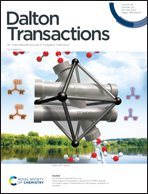Encapsulation of Cu nanoparticles in nanovoids of plate-like silica sodalite through interlayer condensation of Cu2+ ion-exchanged layered silicate RUB-15†
Abstract
The interlayer condensation of layered silicates is a unique method for synthesizing zeolites and is effective for the introduction of metal species into platy zeolite frameworks. Layered silicate RUB-15 is a useful starting material because metal ions can be introduced between the layers and zeolite frameworks (all-silica SOD-type zeolite; silica sodalite) can be formed through interlayer condensation. In this study, Cu ions were intercalated into layered silicate RUB-15, and metal Cu nanoparticles were formed in the nanovoids of silica sodalite by a simple heat treatment in an inert atmosphere. Both interlayer condensation and the reduction of Cu2+ ions were confirmed by in situ XRD analysis performed during the heat treatment. The residual interlayer tetramethylammonium ions played two roles: the control of stacking sequence in the interlayer condensation and the reduction of Cu2+ ions. The formed Cu nanoparticles were stable in air atmosphere because of their confinement in the nanovoids of the sodalite frameworks.



 Please wait while we load your content...
Please wait while we load your content...